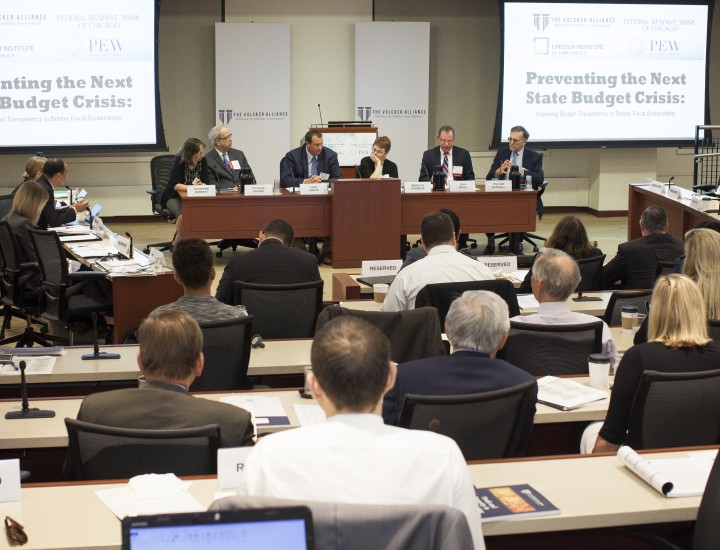Budget Professors Meet with Alliance to Map Truth and Integrity in State Budgeting Expansion

Professors from a dozen leading universities and academic institutes of public administration and public policy joined Volcker Alliance Chairman Paul A. Volcker, board member Richard Ravitch, and members of the Alliance’s state and local program team in New York to discuss expanding the Truth and Integrity in State Budgeting project from the initial three to all fifty states.
It is an opportune time to evaluate how states put their budgets together. Only days after the Alliance's state and local program director Bill Glasgall and Project Manager Melissa Austin led the meeting with academics, the Nelson A. Rockefeller Institute of Government observed that state tax revenue growth cooled significantly in last year’s third quarter and is likely to slow even further through 2016 and 2017.
Unless expenditure growth also declines at a similar pace, pressures will mount on political leaders to find expedient solutions to balance their budgets—just the sort of techniques the Alliance identified in its 2015 report, Truth and Integrity in State Budgeting: Lessons from Three States and follow-up working paper, Beyond the Basics: Best Practices in Budget Transparency. Indeed, political gridlock over finding such fiscal solutions has left two states—Illinois and Pennsylvania—without enacted budgets for the current fiscal year that ends in less than four months.
At the New York meeting with professors, Bill and Melissa, along with Alliance consultants Thomas Doe, Matt Fabian, and Lisa Washburn of Municipal Market Analytics Inc., and the husband-and-wife writing team of Katherine Barrett and Richard Greene, reviewed the original research methodology of the Truth and Integrity report. Using publicly available budget and supplemental documents as well as interviews with fiscal experts, that report focused on the budget process—how states forecast revenue and expenditures and the extent to which they balance each year’s books by funding current expenditures with current revenues, or shifting costs, such as pension contributions or infrastructure investment, to future generations of citizens.
In discussing a nationwide expansion of the project, participants reviewed ways to rank states’ budget performance and possible refinements to the research methodology used in the three-state report. Ideas raised included improving scrutiny of rainy day funds and other fiscal reserves; gauging the existence of structural budget deficits; and tracking the use of tax abatements and similar budget expenditures generally aimed at stimulating job growth. The group also discussed ways to improve states’ fiscal responsibility by making data collected through the project as well as findings available online and without cost to elected officials, budget staffs, researchers, and the general public.
While budget challenges are hardly a new phenomenon—the state of Alabama’s first budget, in 1819, showed expenditures of $32,331 with only $22,111 in funds to pay for them—the cost and complexity of today’s state fiscal challenges, and those facing counties and cities as well, has multiplied exponentially. In gearing up the Truth and Integrity in Government Finance project to cover all 50 US states, the Volcker Alliance is preparing to chart the daunting task of meeting those challenges and the cost to Americans if they are ignored.
